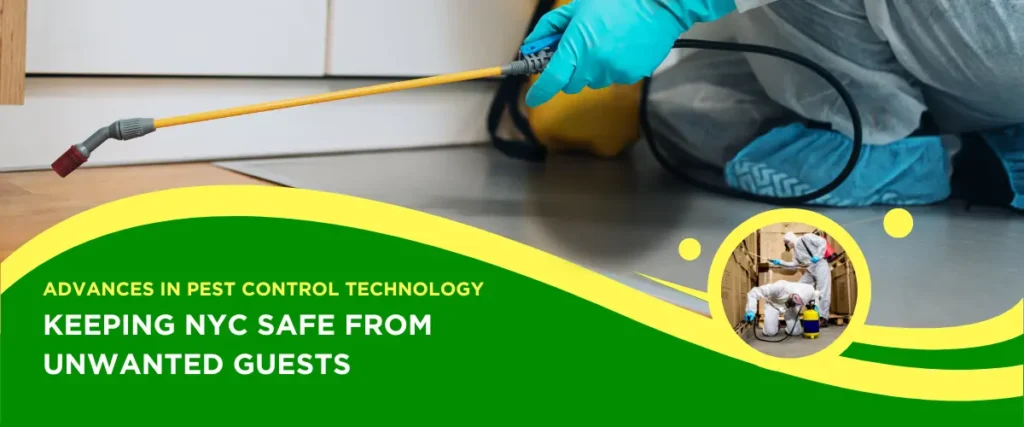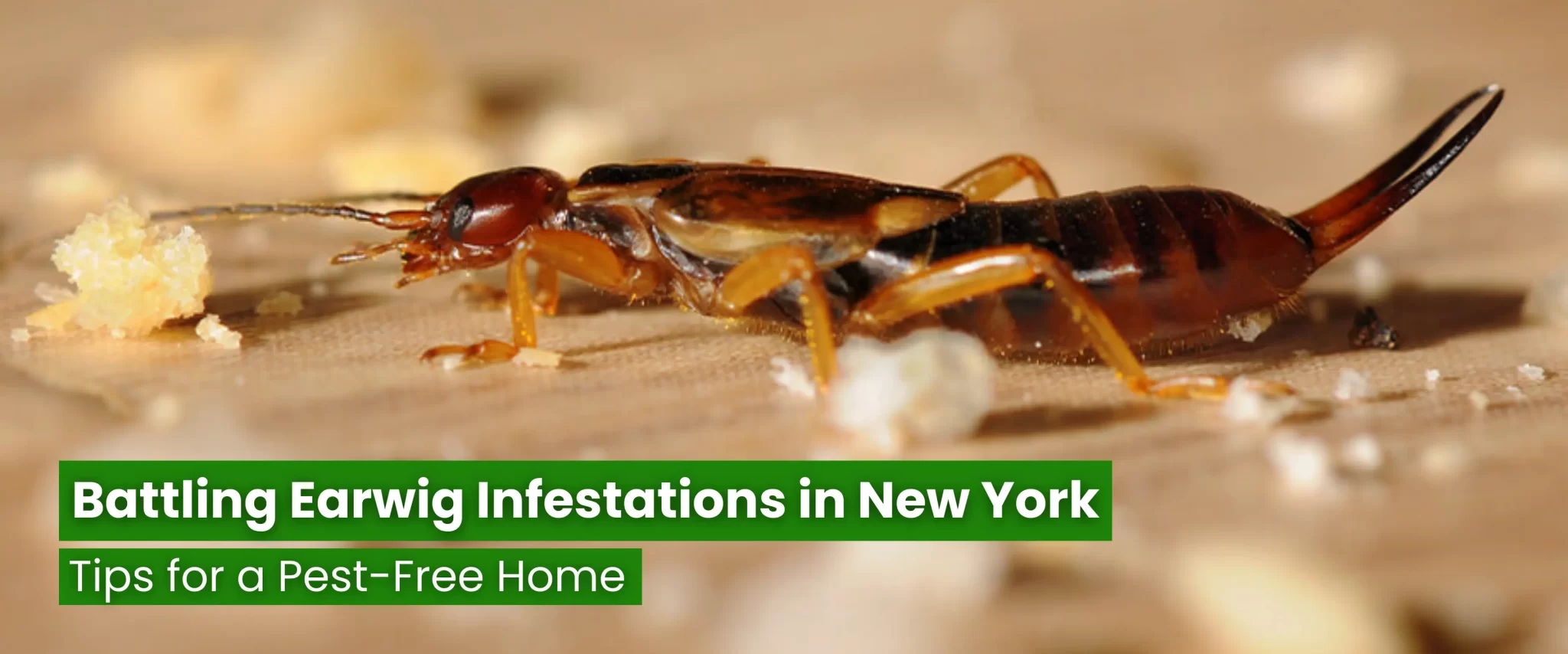
Battling Earwig Infestations in New York: Tips for a Pest-Free Home
Earwigs, those small, pincer-tailed insects, are a common nuisance in many parts of the world, including New York City. These creatures, often associated with damp and dark environments, can be particularly bothersome when they invade homes and gardens.
While earwigs may not pose a significant health threat to humans, they can be quite annoying and destructive. They are known to damage plants, contaminate food, and create a sense of unease in the home. It is essential to identify and address earwig infestations promptly to prevent further problems.
Identifying Earwigs
Earwigs are small, nocturnal insects with a distinctive appearance. They have elongated, flattened bodies that are typically brown or black in color. One of their most recognizable features is their pair of pincers on their abdomens. These pincers are used for defense and to capture prey.
Comparison with Other Insects:
- Black bug with 6 legs and antenna: While there are many black insects with six legs and antennae, earwigs can be distinguished by their elongated bodies and pincers.
- Bugs similar to earwigs: Some insects, such as silverfish and centipedes, may resemble earwigs. However, silverfish have silvery bodies and lack pincers, while centipedes have many more legs.
Visual Characteristics of Earwigs:
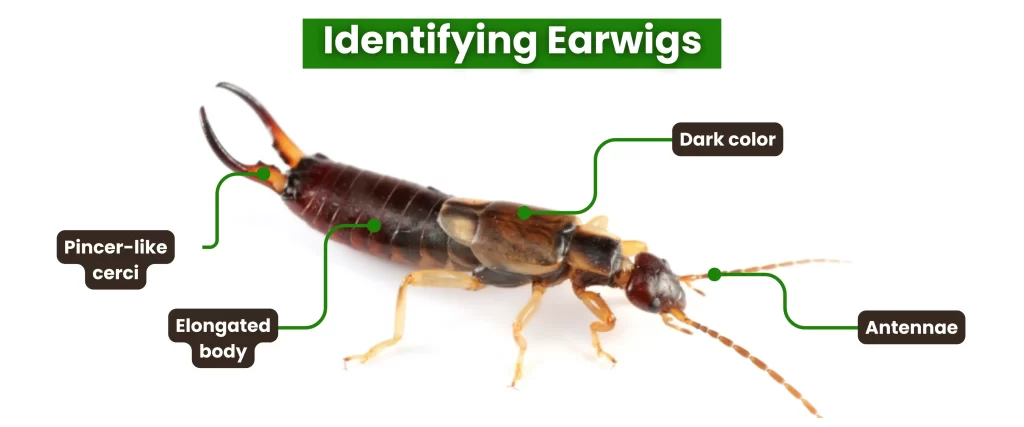
- Elongated body: Earwigs have a long, flattened body.
- Pincer-like cerci: The most distinctive feature of earwigs is their pair of pincers on their abdomens.
- Dark color: Earwigs are typically brown or black in color.
- Antennae: They have two long antennae.
Why Are They Called Earwigs?
The origin of the name “earwig” is somewhat unclear. One popular theory suggests that the name comes from the belief that earwigs crawl into people’s ears. However, there is no scientific evidence to support this claim.
Debunking the Myths:
- Earwigs do not crawl into ears: This is a common myth that has no basis in fact.
- The name may be derived from old English: Some experts believe that the name “earwig” may be derived from the Old English words “ear” and “wig,” which could mean “ear worm.”
What Is an Earwig Infestation?
An earwig infestation occurs when a significant number of earwigs invade a home or other structure. These insects are attracted to damp, dark environments, and often seek shelter indoors to escape harsh weather conditions.
Signs of an Infestation:
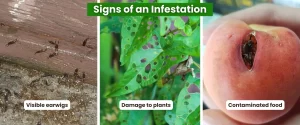
- Visible earwigs: The most obvious sign of an infestation is seeing earwigs crawling around your home. They are often found in dark, moist areas, such as:
- Basements
- Bathrooms
- Kitchens
- Under sinks
- In cracks and crevices
- Damage to plants: Earwigs can damage plants by feeding on leaves, flowers, and stems.
- Contaminated food: Earwigs may contaminate food by crawling over it.
Are Earwigs Dangerous?
While earwigs can be unsightly and annoying, they are generally not dangerous to humans or pets. They do not bite or sting, and they are not known to transmit diseases.
Common Myths About Earwigs:
- Earwigs crawl into ears: This is a common myth, but earwigs are not attracted to ears.
- Earwigs are poisonous: Earwigs are not poisonous and do not pose a health risk.
- Earwigs are harmful to pets: Earwigs are not typically harmful to pets, but they can be a nuisance if they invade their bedding or food bowls.
What Are Earwigs a Sign Of?
Earwigs are often a sign of a favorable environment for these insects. Their presence can indicate:
- Excess moisture: Earwigs thrive in damp conditions, so their presence may suggest a moisture problem in your home.
- Organic matter: Earwigs are attracted to decaying organic matter, such as food scraps or plant debris.
- Shelter: They seek out dark, secluded places to hide during the day.
Factors Contributing to Earwig Infestations:
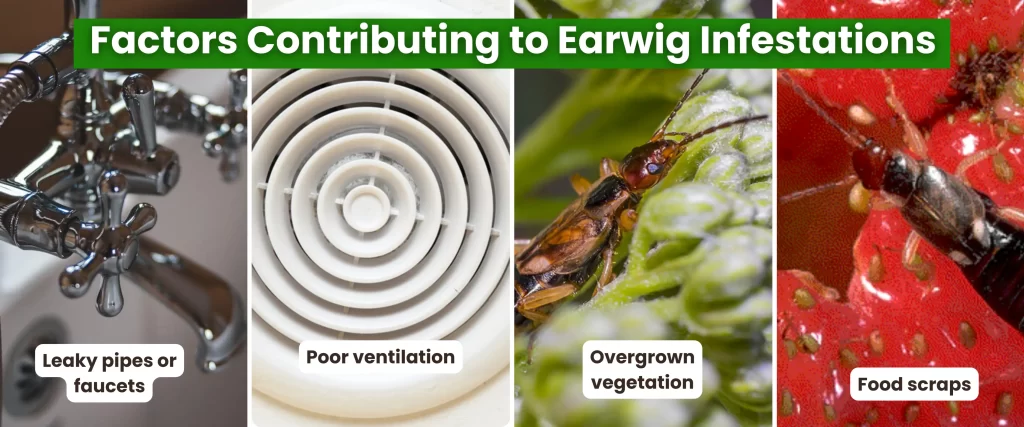
- Leaky pipes or faucets: These can create damp conditions that attract earwigs.
- Poor ventilation: Insufficient ventilation can lead to moisture buildup.
- Overgrown vegetation: Dense vegetation around your home can provide a hiding place for earwigs.
- Food scraps: Leaving food scraps lying around can attract earwigs.
What Attracts Earwigs?
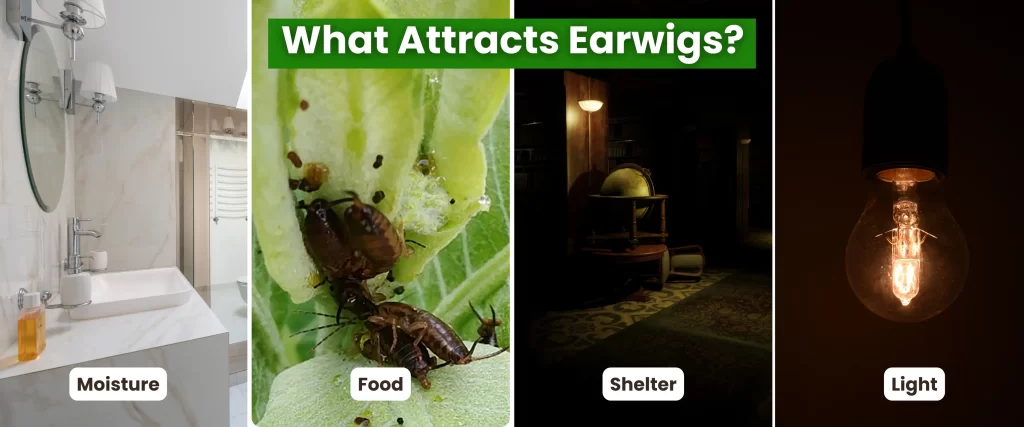
Earwigs are attracted to a variety of factors, including:
- Moisture: They are drawn to damp areas, such as basements, bathrooms, and kitchens.
- Food: Earwigs are omnivores and will eat a variety of food, including decaying plant matter, insects, and even small pieces of meat.
- Shelter: They seek out dark, secluded places to hide during the day.
- Light: Earwigs are attracted to light, especially at night.
Reducing the Attractiveness of Your Home to Earwigs:
- Eliminate moisture sources: Repair leaky pipes and faucets, and improve ventilation in your home.
- Clean up food scraps: Dispose of food scraps promptly and store food in airtight containers.
- Remove clutter: Clutter can provide hiding places for earwigs.
- Trim vegetation: Keep vegetation around your home trimmed to reduce hiding places.
- Seal cracks and crevices: Seal any cracks or crevices in your home’s exterior to prevent earwigs from entering.
- Use natural repellents: Some natural repellents, such as diatomaceous earth or peppermint oil, can help deter earwigs.
Earwig Season
Earwigs are most active in New York during the warmer months, from late spring to early fall. This is when temperatures are ideal for their development and activity. However, infestations can occur throughout the year, especially in homes with favorable conditions for earwigs.
Seasonal patterns can significantly affect earwig infestations. During the warmer months, earwigs are more likely to be found outdoors, feeding on plants and seeking shelter in damp, dark places. As temperatures cool down in the fall, earwigs may seek refuge indoors to escape harsh weather conditions.
Earwigs vs. Similar Bugs
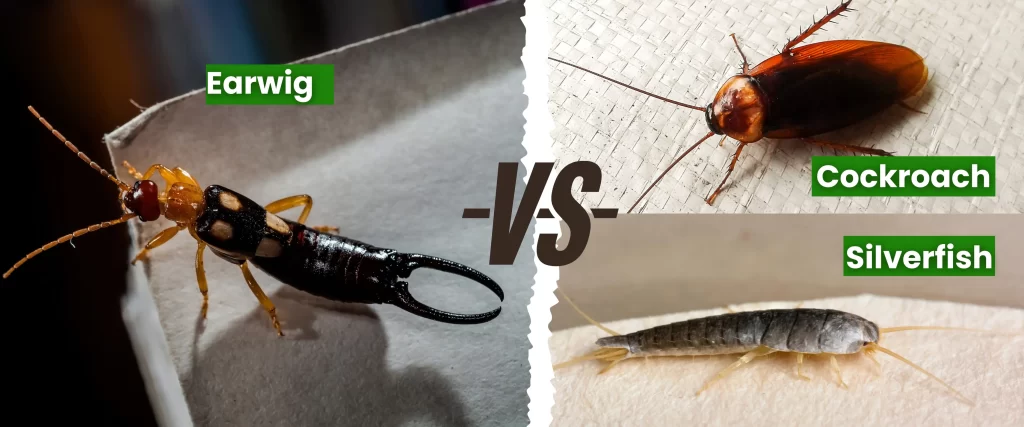
Earwigs vs. Cockroaches:
- Appearance: Cockroaches are typically larger and have a more flattened body than earwigs. They also have longer antennae.
- Habitat: Cockroaches are more likely to be found in kitchens and other areas with food sources, while earwigs are often found in damp, dark places.
- Behavior: Cockroaches are active both day and night, while earwigs are primarily nocturnal.
Earwigs vs. Silverfish:
- Appearance: Silverfish have silvery bodies and lack pincers. They also have longer, more slender antennae.
- Habitat: Silverfish are often found in damp, dark places, similar to earwigs. However, they may also be found in bookshelves and other areas with paper products.
Other Bugs That Look Similar to Earwigs:
- Centipedes: Centipedes have many more legs than earwigs and lack pincers.
- Firebrats: Firebrats are similar in appearance to silverfish but have a reddish-brown color.
How to Control Earwigs
Effective Methods for Managing Earwig Infestations:
- Diatomaceous earth: This natural powder is harmful to insects but safe for humans and pets.
- Borax: Borax can be used to create a homemade earwig bait.
- Sticky traps: Sticky traps can be placed in areas where earwigs are often found.
- Vacuuming: Regularly vacuuming your home can help to remove earwigs and their eggs.
- Sealing cracks and crevices: Seal any cracks or crevices in your home’s exterior to prevent earwigs from entering.
- Removing moisture sources: Repair leaky pipes and faucets, and improve ventilation in your home.
Preventative Measures:
- Keep your home clean and dry: Regularly clean up food spills and crumbs, and eliminate moisture sources.
- Trim vegetation around your home: This can help to reduce hiding places for earwigs.
- Store food in airtight containers: Store food in airtight containers to prevent earwigs from accessing it.
- Use natural repellents: Some natural repellents, such as peppermint oil, can help deter earwigs.
When to Consider Professional Pest Control Services to Control Earwigs Infestation:
While many earwig infestations can be managed with DIY methods, there are times when professional pest control services may be necessary:
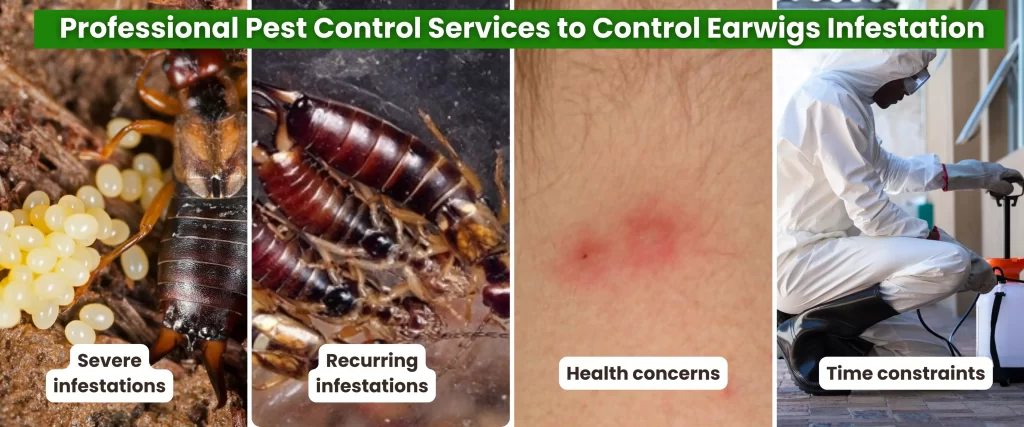
- Severe infestations: If you have a large infestation or if earwigs are causing significant damage to your home or property, professional help may be the best option.
- Recurring infestations: If earwigs keep coming back despite your efforts to control them, a professional pest control company may be able to identify the underlying cause and implement effective solutions.
- Health concerns: If you or a family member has allergies or other health issues that are aggravated by pests, it’s important to seek professional help to eliminate the infestation.
- Time constraints: If you don’t have the time or expertise to deal with an earwig infestation on your own, a professional can handle the problem efficiently and effectively.
Conclusion
Earwigs can be a nuisance, but with proper identification and control measures, they can be effectively managed. By understanding the characteristics of earwigs, identifying signs of infestation, and implementing effective control methods, you can create a pest-free home in New York.
Remember to maintain a clean and dry environment, eliminate moisture sources, and seal cracks and crevices in your home to prevent future earwig infestations. With a little effort, you can enjoy a peaceful and earwig-free living space.

